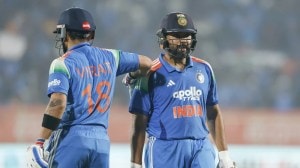Gandhi after Godse: The afterlife of the Mahatma
Rammanohar Lohia mentioned that there are three Gandhis — governmental, priestly, and heretic. The heretic Gandhi continues to be a moral force, galvanising the resistance to political, material, and spiritual tyrannies. This is the Gandhi Godse failed to understand or murder.
 The heretic Gandhi continues to be a moral force, galvanising the Last Man and Woman to resist political, material, and spiritual tyrannies. (Express archives)
The heretic Gandhi continues to be a moral force, galvanising the Last Man and Woman to resist political, material, and spiritual tyrannies. (Express archives) In 1968, Malayalam scholar-poet N V Krishna Warrier wrote Mohandas Gandhiyum Nathuram Godseyum (Gandhi and Godse). Warrier, an active participant in the Quit India Movement, captured in his long poem the disillusionment of a generation that felt betrayed by the leaders of independent India.
In the poem, Gandhi and Godse are representative men of opposing moral visions. Just two decades after Independence, Godse has triumphed over Gandhi and is ever successful in his avatars as a robber baron, politician, and minister. He spots Gandhi, the daridra narayan, queuing at the ration shop and wonders if he had wasted three bullets. Warrier, of course, draws the Gandhi-Godse encounter in the binaries of good and evil, idealism and corruption, but ignores the ideological dimensions that made Godse and his fellow men plot Gandhi’s murder. But then no one in the 1960s may have foreseen the resurrection of Godse as a political icon. In the past few years, there have been reports of Hindu Mahasabha activists and others commemorating him and even staging mock assassinations of Gandhi.
The Gandhi assassination was a political murder by a political activist with close links to the Hindu Mahasabha and the Hindutva ideology. In his statement at the Red Fort trial, Godse listed the reasons, all political, for carrying out the murder. Nathuram’s brother Gopal Godse has given a detailed account of their ideological moorings and Nathuram’s closeness to his mentor, V D Savarkar, in his book, Gandhiji’s Murder and After. Gopal Godse and Savarkar too were arrested in the Gandhi assassination case. The former was convicted while the latter was acquitted. Godse killed Gandhi on the evening of January 30, 1948. Godse was executed by the state for his action on November 15, 1949. Seven decades later, many see Gandhi as irrelevant, if not a failure, while Godse’s worldview has seen a resurgence.
At the Gandhi Smriti on Tees January Marg in Delhi, where the Mahatma stayed during the last 144 days of his life and was shot by Godse, there is no mention of the politics that shaped the murder. It may well be the case if a visitor thought Gandhi was killed by a random insane person who found a target at a convenient space, time, and distance. It is as if the nation and its people do not wish to confront the politics of hate that Godse represented. The last years of Gandhi were spent fighting it. In death too, he defeated it, at least for some years. It took decades and the Emergency for the Hindu right to regroup and find widespread legitimacy for its political agendas.
However, the revival of Hindu right-wing politics started in the 1960s itself with the restoration of Savarkar as a national icon. The BJP government in 2003 even had his picture mounted on the walls of Parliament Central Hall. Hindutva, the exclusivist political agenda that Savarkar outlined as the ideological fount of Hindu Rashtra, is championed by the ruling BJP. Hindutva foregrounds Hinduness as the primary criterion of Indian citizenship. State policies such as the Citizenship Amendment Act underline the influence of Hindutva.
Savarkar has always been the main ideological foe of Gandhi. There were other political adversaries and critics of Gandhi such as Babasaheb Ambedkar and the Communists, but in the Indian context the competing visions of the Indian nation mainly belonged to Savarkar and Gandhi. Savarkar envisaged a Hindu nation-state and differentiated between those who followed Semitic faiths such as Islam and Christianity and Indic religious traditions. For Gandhi, Truth was God and every religion at its core recognised it. His world of ideas was cosmopolitan — his influences ranged from the Gita to Anekantavada of Jaina philosophy to Sermon on the Mount to John Ruskin’s Unto this Last and Leo Tolstoy’s The Kingdom of God is Within You. Swaraj and Sarvodaya were rooted in self-respect and self-reliance; they had no place for nativism, wounded religious pride, and victimhood. Gandhi’s ahimsa rejected all forms of violence, political, social, and economic. He practised a form of inclusive ethics and spirituality.
Philosopher Ramchandra Gandhi writes, “This new and adventurous and exciting way of getting into everyone’s heart, and really finding out about the other. In fact, discovering that there is no other, to find your Judaism in your Hinduism, and your Christianity in your Buddhism, and your atheism in your Jainism, and Jainism in your music.” This is how Ramchandra Gandhi describes Gandhi’s unique moral vision: “The history of morality in the last 100 years has been a history of painful approach to a species conception of morality. But even that is old, even that is not going to work. The new way of practising morality would be to say all creatures are my brothers and sisters! Not only all communities, nations and cultures, but all creatures, and not only all creatures, but all beings, including that which appears to be living, like water, like air, like space, like fire; but not only that, empty space is also my fellow, really. To love emptiness, not to clutter it with objects, with greed. That is the new morality.”
This new ethics, new morality is the essence of the living Gandhi, the Gandhi whom Savarkar, Godse and even the Indian nation-state have failed to kill or tame. Rammanohar Lohia, the most creative interpreter of the radical Gandhi, mentioned that there are three Gandhis — governmental, priestly, and heretic. Of these, the governmental and the priestly Gandhis have been mummified in sarkari programmes such as Swachh Bharat Mission and are projected as props in the photo-ops involving state dignitaries at Raj Ghat and Sabarmati Ashram.
The heretic Gandhi continues to be a moral force, galvanising the Last Man and Woman to resist political, material, and spiritual tyrannies. He was spotted among the women of the Chipko movement, the dam oustees in Narmada, in Shaheen Bagh. He spoke through Khan Abdul Ghaffar Khan, Martin Luther King Jr, J C Kumarappa, Ernst Schumacher, Nelson Mandela, Laurie Baker, Joan Baez, and so many others, known and unknown people, celebrities and ordinary people. This Gandhi, of Hind Swaraj and Constructive Programme, is the Gandhi that Godse failed to understand or murder. This Sanatani Hindu is the counter to the militant and sectarian faith that the camp of Savarkar and Godse claim as Hinduism and national religion. He is the eternal Gandhi, the realisation that Truth alone is God.
amrith.lal@expressindia.com
- 01
- 02
- 03
- 04
- 05































